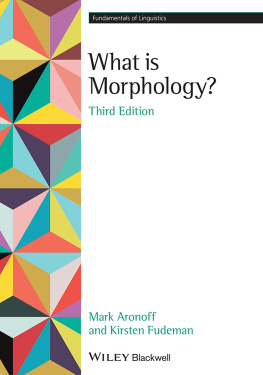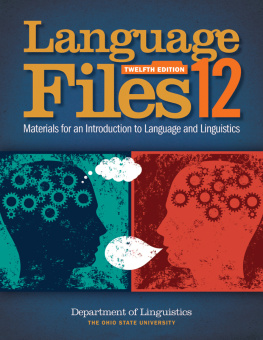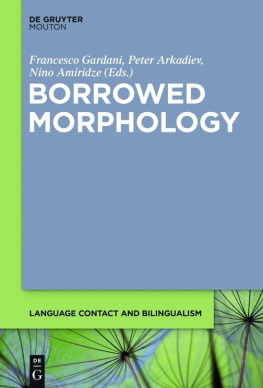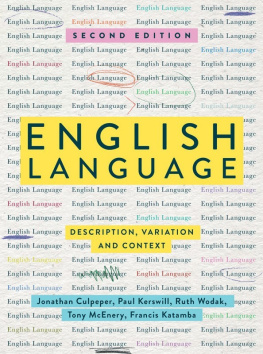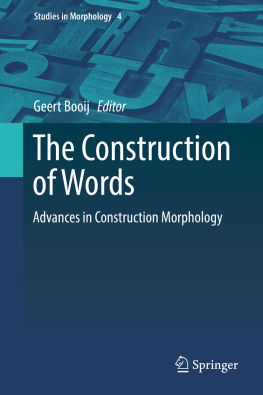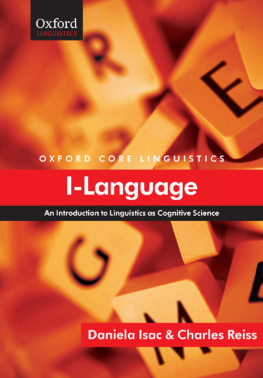Glossary
See
apophony.In ergative case systems, the case associated with the object of a transitive verb or the subject of an intransitive one.The morphological case of nouns, pronouns, adjectives, and participles that occupy the position of object to the verb or some prepositions. Nouns and pronouns are typically assumed to receive accusative case by government, while adjectives and participles receive it by agreement with the noun.acronymA word derived by taking the initial letter of all or most words in a string and pronouncing them together, e.g., scuba < self-contained underwater breathing apparatus.See
voice.adjectiveA word that can function as the head of an adjective phrase (AdjP). Adjectives qualify or describe the referents of nouns. Examples of adjectives include
large,
quiet,
indispensable, and
ambiguous.A word that modifies a verb, an adjective, another adverb, or a preposition, or a larger unit such as a phrase or sentence. It often expresses some relation of manner or quality, time, or degree. Examples include
quickly,
often,
carefully,
soon, and
very.affixA bound morpheme that attaches to a root or stem to form a new lexeme (derived form) or an inflected form or stem of an existing lexeme.Adjective applied to languages or to morphology characterized by words containing several morphemes, of which one belongs to a lexical category and the others are clearly identifiable affixes, each with a single semantic function.The process by which one lexical category is inflected to express the properties of an other, or the result thereof, e.g., a verb bearing person and number morphology that reflect those of the subject. Also called concord.Two or more instances of a given sign (morpheme) with different shapes; variants. E.g., [t], [d], and [d] are allomorphs of the English past tense suffix.The creation of linguistic forms based on a proportion A : B :: C : X, in which the pattern seen in two or more forms, represented here by A and B, is extended to other forms.A language whose words usually contain only one morpheme.animate genderIn languages that divide nouns into classes on the basis of animacy, the noun class that consists primarily of words denoting living things. Animate gender contrasts with inanimate gender.apophonySystematic vowel changes in a root that signal a morphological contrast; also referred to as internal change. In Germanic languages such as English, this process is usually called ablaut, e.g.,
sing,
sang,
sung;
swim,
swam,
swum. Ablaut may be accompanied by suffixation, as in the past participles of the following sets:
give,
gave,
given;
write,
wrote,
written.See
prototype.An inflectional category that encodes the relationship of an event or action to the passage of time, especially in reference to its duration, completion, or repetition. For example, the perfect is a verb form that expresses an action or state that has ceased or been completed at the time of speaking or a time spoken of.Said of inflectional categories, such as case, that are not inherent to a word, but that are the result of government or concord with another element in an utterance.assimilationSaid to occur when one segment takes on one or more phonetic characteristics of another one, such as nasality, place of articulation, or voicing. Progressive assimilation is said to take place when the characteristic spreads forward. Regressive assimilation is said to occur when the characteristic spreads backwards.A derived form that indicates an increase in size, force, or intensity as compared to the base word; the morpheme that results in such a derived form.A morphological process in which a real or imagined affix is removed from an existing word to create another, e.g.,
editor > edit,
liaison > liaise.The root or stem to which an affix attaches.blendA word derived by combining parts of two or more other words, e.g.,
smog < smoke and
fog.The process by which a potential word is prevented from occurring in a language because another form with the same meaning and function already exists.A morpheme that may not stand on its own and must be attached to a stem.A morphological category that encodes information about a words grammatical role, e.g., subject, direct object, indirect object, possessor.circumfixA bound morpheme made up of two parts, one that occurs before and one that occurs after the root.Term that refers to the form of a lexemes paradigm that is used by linguists to refer to the lexeme. Morphologists often give the citation form in small capital letters.class 1 affixesSee
primary affixes.class 2 affixesSee
secondary affixes.clippingA word-formation process by which a word is created by lopping off part of another word, e.g.,
Will < William.Morphemes that behave syntactically as words, but, unlike words, cannot stand alone phonologically and must be incorporated into the prosodic structure of an adjacent word.A suffix that may not be followed by any others. Typically, when we say that a derivational suffix is a closing suffix, we mean only that it cannot be followed by another derivational suffix. It may be followed by inflectional morphology.The consonant or consonants that follow the nucleus in some syllables.cognitive neuroscienceThe branch of neuroscience that studies the biological foundations of mental phenomena.The creation of a new word not by any derivational process. Also called word manufacture.The knowledge that speakers have of their language. Contrasts with performance.A morphological form that consists of more than one morpheme, whether it be two or more stems (compound word) or a stem plus one or more affixes, e.g.,
bookstore, optimality.Defined (e.g., a word) entirely in terms of its parts.compoundA derived form resulting from the combination of two or more lexemes, e.g.,
space + ship > spaceship.concatenativeTerm that describes morphology that builds words by the linear addition of morphemes.See
agreement.The set of forms associated with a verbal lexeme.A word such as
calendar,
sadness,
die,
speak,
quiet,
quickly, or
tomorrow that refers to objects, events, and abstract concepts; contrasts with function word. Also called lexical word.Inflection that involves a simple directional mapping between a morphosyntactic feature and a particular phonological string. An example is the suffix -
ing on present participles in English, because all present participles bear the same suffix. Contrasts with context-sensitive inflection.Said of inflection when the realization of a morphosyntactic feature varies. An example is past tense in English, which may be realized by ablaut, suppletion, or the addition of a suffix. Contrasts with context-free inflection.Affix whose addition to a word X results in one that means opposite of X, e.g.,
un-,
in-.See
logical negator.conversionSee
zero-derivation.See
exponence.In languages with case, the one likely to be assigned to indirect objects.declensionIn some languages, the inflection of nouns, pronouns, and adjectives for categories such as case, gender, and number.The creation of a new lexeme from one or more other lexemes through the application of some morphological process, such as affixation or compounding. Also called lexeme formation and word formation. Derivation contrasts with inflection.See
number.dual-route modelsSee
single-route and dual-route models.A clitic that attaches to the end of a word.Said of compound words that have a head. For example, the head of

